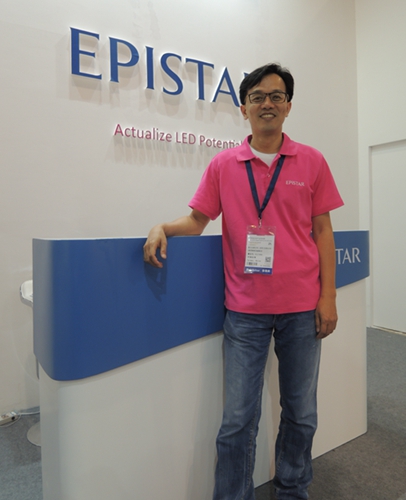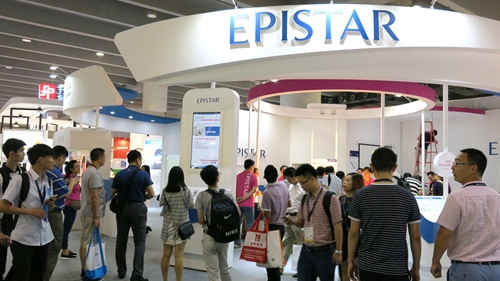(Authors: Sophie Liu, Editor, LEDinside and Ivan Lin, Editor-in-Chief, LEDinsidehttp://Translator: Judy Lin, Chief Editor, LEDinside)
The global LED industry benefited from emerging lighting market demands, but the LED backlight industry has entered a mature plateau phase. Price wars intensified in mainstream LED chip and application sectors, turning into an overtly competitive red sea market. In 2015, global LED market value declined for the first time by 3% to US $14.33 billion, according to statistics compiled by LEDinside, a research division of Taipei-based market research institute TrendForce.
Certain LED manufacturers are swapping strategies following changes in the industry, while a couple of large LED manufacturers are actively seeking new blue sea markets to facilitate market strategies in sectors including LED filament bulbs, automotive LEDs, grow lights, smart lighting, IR/UV, micro-LED and other innovative and special lighting application markets.
Epistar is one of the leading LED EPI-wafer manufacturers in China and Taiwan, and possesses certified LED patents and intellectual property network. The company is a veteran in product portfolio, and in the face of new market conditions, Epistar implemented a dual track strategy, where the company deploys its business strategy in conventional lighting and backlight markets, the other track focuses on market strategies in niche lighting applications. Epistar’s developments in innovative lighting markets and current conditions are worth exploring, said the company’s Marketing Center project director HK Chen.
 |
|
HK Chen, project director, Marketing Center, Epistar. (All photos courtesy of LEDinside) |
Epistar establishes footing with strong LED filament patent portfolio
Similar to hit singles on an album, LED filaments were Epistar’s “featured song” at Guangzhou International Lighting Show 2016 (GILS 2016). LED filaments took the center spotlight at the company’s booth in Guangzhou this year.
Epistar is one of the pioneers in the LED filament industry, and acquired transparent substrate related patents as early as 2007. The Taiwanese manufacturer has invested resources in LED filament technology for years to improve filament efficiency.
Benefiting from its long term LED filament R&D and patent strategy deployment, the company possesses comprehensive LED chip and filament patents, as well as LED filament bulb structure patents. The company is licensing its patents to manufacturers in the midstream and downstream sector of the LED industry to advance its clients market competitiveness. Moreover, Epistar’s close partnership and long term collaboration with China’s largest LED package manufacturer MLS, has made the Chinese company one of its most important clients. Epistar’s LED filaments are only being sold to MLS, and the Taiwanese company is evaluating whether to take the cooperation to the next level. Epistar has licensed its LED filaments to three important Chinese LED lighting manufacturers Leedarson, Foshan Lighting, and Jinn Yang Technology (Jinn Yang). Jinn Yang is a joint venture set up by Epistar and Yuzhong Gaohong Lighting Electrical Equipment (YGLEE) that initially specialized in bulb manufacturing, with roots in incandescent bulb manufacturing. The company is a veteran in bulb manufacturing and production lines. Epistar supplies LED chips to Jinn Yang, which is then manufactured into LED filaments, and finally handed over to YGLEE for retail. The division of work benefits both companies.
Current issues in the LED filament market include “premature price wars in spite of immature technology.” According to Epistar, the plunging prices in the LED filament market is triggered by the lack of respect for intellectual property in the industry. In comparison, market prices of products with intellectual property are relatively stable. Additionally, products with guaranteed quality, volume, and aesthetics can also boost its market competiveness and value.
In the export market, patent protected LED filament bulbs are more likely to be procured by distributors.
 |
|
Epistar's booth at Guangzhou International Lighting Fair in June 2016. |
Epistar provides comprehensive solution in invisible light market
The invisible LED market is one of the most important in the LED industry, due to the market’s higher retail price and gross margin per LED. With more manufacturers entering the invisible light sector, where is Epistar’s entry point?
Currently, most of Epistar’s small IR LED products are applied in long distance IR receivers, and its high power LEDs in surveillance applications. Epistar’s IR LED products delivered stellar performance in smartphones and surveillance sectors, and has been able to improve its product features every year.
In 2016, the IR LED market value excluding optical sensor components market reached about US $278 million, and is expected to reach US $525 million by 2020, in which IR LEDs in surveillance market value reached US $174 million, estimated LEDinside.
“Wearable devices have continued to adapt optical sensor components, and with rising demands from smartphone brands, optical sensor demands will grow considerably this year,” said Joanne Wu, Assistant Manager, Research Division, LEDinside.
Optical sensors are a very mature and commercialized application sector in the invisible LED sector. Application sectors for optical sensors in smartphones to detect ambient lighting, distance detection, and IR products for Industry 4.0, such as industrial photointerrupters, robot arms, IR detection and others.
In the emerging UV LED industry, the most common application is nail curing which uses UVA LEDs with a wavelength range of 390 nm to 410 nm. Due to the low technology entry level, UVA LED prices plummeted in the last two years. Following improvements in LED luminous efficiency, industrial curing, exposurers and other mid and high power LED applications are starting to use LEDs, resulting in rising market penetration rates. Industrial lighting applications mainly use UVA LED products with 365 nm wavelength, and the sector has large market potential. Higher requirements in the industry for reliable products with precise wavelengths and stable prices, has also become a main focus for Epistar. UVC applications are mostly in sterilization and killing germs, shorter wavelengths are able to achieve better effects. Manufacturers in the industry are trying to acquire market shares in food sterilization industry, and swarming in UVC developments. Most applications in the industry fall between 279 nm-300 nm, and in the UVC LED industry R&D is mostly invested in improving luminous efficiency and making products with shorter wavelengths, which are two parameters that Epistar is working on.
Additionally, Epistar is no longer adhering to traditional retail and marketing strategies, the company is directly selling its products to LED package clients after commercializing products in R&D labs. The Taiwanese chip maker is in close contact with package manufacturers and end market application manufacturers in the R&D phase to better understand client demands. By collaborating with clients, the company is able to guarantee the product reliability, and provide clients with the most comprehensive product solution.
Advancements in LED grow lights and automotive lighting sector
In early June 2016, the president of China Xi Jinping visited a vertical farm lit with smart LED grow lights, which attracted a lot of attention from the grow light market. Epistar, led the market in LED grow light deployment, and has been cooperating closely with international manufacturers in 2008 to meet client and market demands. Epistar was able to improve LED grow light product performance and stabilize revenue annually.
Epistar’s LED grow light products can be divided into two main product lineups “greenhouse lights” and “artificial lights”. High pressure sodium lights that were conventional grow lights in greenhouses are gradually being replaced by high power LED light sources, while fluorescent lights are being substituted with mid power LEDs.
Different plants have various lighting demands and finding specific wavelength can optimize plant growth yield rates, hence LED grow light trends are shifting towards integrating multiple wavelengths to fully take advantage of LED strengths, such as easily adjusting light quality and illumination. For instance LED grow light combinations encompasses adding white LEDs in red LED grow lights, or adding blue LED in red LED grow lights, or even adapting UV LED in plant grow light applications.
The automotive LED lighting market is impacted by electric vehicles (EV), and other car brands carbon emission reduction policies, which expanded automotive LED procurement demands. Epistar accumulated years of certification experience with car manufacturers, and its related LED products were granted TS16949 certification. Additionally, the company has formed strategic partnerships with several European and Japanese automotive lighting manufacturers.
In automotive LED business, Epistar is focusing on product quality and volume, especially in lead time, due to automotive products inventory requirement of at least seven years. Epistar is maintaining automotive LED production capacity to offer clients steady supplies, despite of reduced LED usage volume. Additionally, the products have much higher requirements for LED die probing and visual inspection regulations to ensure product quality.
Another factor, is maturing automotive LED lighting applications has resulted in clients rising design demands. In the initial phase of the automotive light design, Epistar and third parties will work on design-in to better understand client demands to improve automotive lighting product design.
Changes in Epistar’s product structure and its focus on emerging lighting application strategies, has allowed it to jump on board the LED lighting trend, which covers the emerging light source market demands. These developments can contribute significantly to the supply chain. It is hoped in the future, Epistar will develop new products and provide new application possibilities.





 CN
TW
EN
CN
TW
EN





